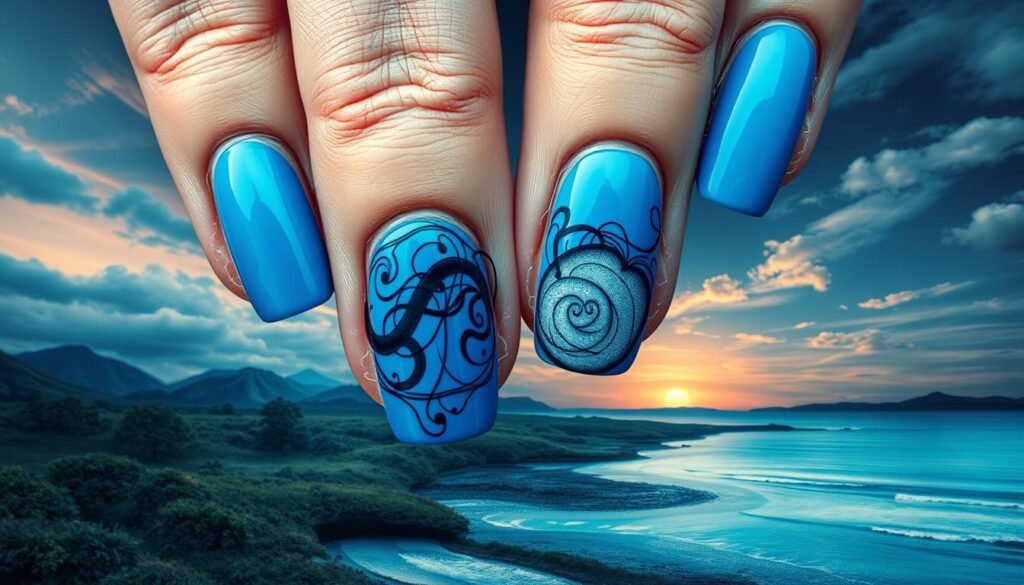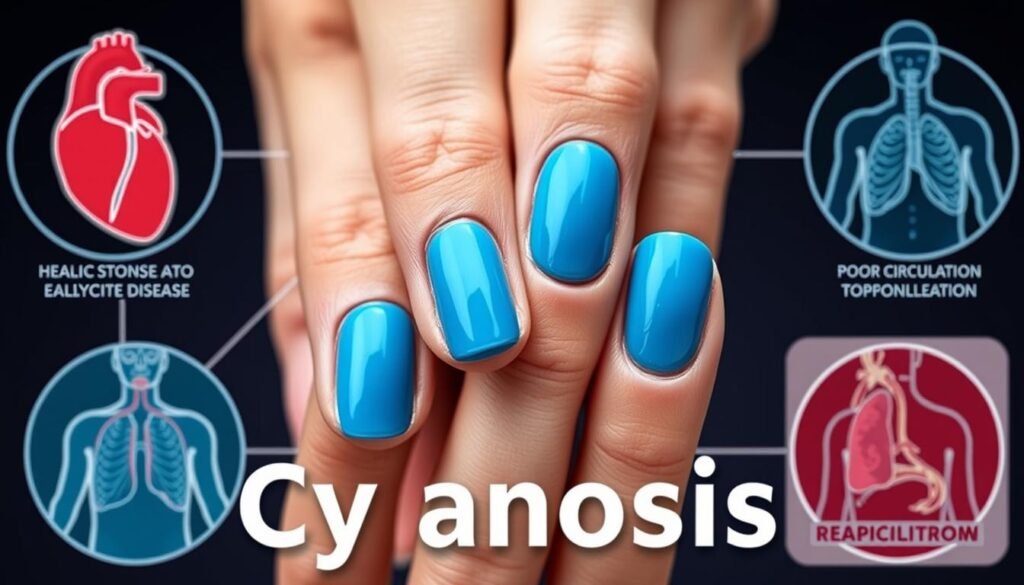Did you know that central cyanosis happens when blood oxygen levels fall below 85%? This is a big sign of possible health problems. Blue fingernails are not just about looks. They are a warning of not enough oxygen in your blood. This condition, called cyanosis, can make many people anxious. It points to health issues that might need quick help. Knowing what blue fingernails mean for health and anxiety is key for being aware of mental health.
Looking into how physical signs like blue fingernails relate to mental health can teach us a lot. It can show us how stress and anxiety show up in our bodies. Spotting these signs early can help handle them better and boost health. For more details, read about the causes and how to know if you have this condition here.
Key Takeaways
- Blue fingernails can show low oxygen in the blood, a sign of serious health issues.
- Knowing how mental and physical health connect is important for well-being.
- Anxiety often shows up in physical ways, affecting how we see our health.
- Cyanosis can come from many breathing and heart issues.
- Noticing blue fingernails early may lead to getting advice from a doctor sooner.
Understanding Cyanosis and Nail Discoloration
Cyanosis makes the skin or nails turn a bluish-purple shade. This happens when blood oxygen levels are too low. This color change is often seen when un-oxygenated hemoglobin is high. Many causes of nail color changes exist, indicating health issues.
Being in the cold can cause cyanosis. Blood vessels get narrow, reducing blood flow to hands and feet. This might go away but can also mean bigger health problems. Cyanosis types – central, peripheral, and differential – show different health risks.
Central cyanosis comes from long-term lung issues or lung birth defects. On the other hand, peripheral cyanosis can happen due to extreme cold, Raynaud’s, heart issues, or shock. Pseudocyanosis is rare but can be caused by medicines like amiodarone.
If you have trouble breathing, chest pain, or feel confused, get help right away. Cyanosis without treatment can lead to serious problems like respiratory or heart failure. Testing includes blood counts, pulse checks, and gas analysis to find the cause of cyanosis.
Nail color changes tell us a lot about our health. Fungal infections often cause them. But, many other diseases and conditions can also change nail color. Blue or purple nails without polish show oxygen isn’t getting delivered right, pointing to circulation problems.
| Cyanosis Type | Common Causes | Potential Risks |
|---|---|---|
| Central Cyanosis | Chronic respiratory diseases, congenital lung abnormalities, pulmonary embolism | Respiratory failure, systemic complications |
| Peripheral Cyanosis | Altitude sickness, Raynaud’s phenomenon, heart attacks, shock | Heart failure, tissue damage |
| Pseudocyanosis | Medication side effects | Variable depending on underlying condition |
Knowing the causes of cyanosis and nail changes is key. Finding and treating these early helps improve health. It’s vital to see a doctor if you notice changes in nail color or your skin.
What Causes Blue Fingernails Anxiety?
Blue fingernails anxiety is caused by a mix of physical and emotional triggers. The condition appears when the body cannot send enough oxygen-rich blood to fingertips. This results in cyanosis, which makes fingernails look blue. This can happen during cold times or with lung and heart problems. Seeing blue fingernails can make people worried about their health.
Seeing the signs of cyanosis can cause stress. When it’s cold or someone is stressed, Raynaud’s phenomenon might make blood vessels spasm. This stops blood from reaching the fingers well. Feeling uneasy about poor circulation is common. People might worry more as their anxiety makes the symptoms worse. This can lead to even poorer blood flow.
With peripheral cyanosis, understanding different health triggers is key. Problems like low blood volume, artery issues, and DVT can cause bluish nails. This raises concern and stress. Knowing why oxygen in the blood decreases can help lessen health worries. Learning about these causes provides important knowledge to reduce anxiety.

Link Between Mental Health and Physical Symptoms
The connection between mental health and physical symptoms shows how complex health psychology is. Anxiety often leads to physical changes, like nail discoloration. These symptoms can make people worry more about their health.
When people feel more anxious, they might notice symptoms that make their anxiety worse. The brain can make the body show signs of stress. For example, some people can’t stop picking at their skin, a condition known as dermatillomania.
This shows us how important it is to understand the link between our minds and bodies. Realizing this connection can help people get the help they need for both mental and physical issues.
Knowing how anxiety and physical symptoms are connected is key. Recognizing how emotional health and physical signs are related can help those affected. It can benefit them to see the link between how they feel emotionally and what their body experiences.

Physical Health Conditions Associated with Blue Fingernails
Blue fingernails can signal lung and heart issues, affecting your health. These changes are usually due to not having enough oxygen in the blood.
Cyanosis causes such as chronic obstructive pulmonary disease (COPD), asthma, and pneumonia lead to lower oxygen levels. These conditions can make your nails and skin change color. It’s a sign that something might be wrong.
Heart problems are important too. Congestive heart failure and heart defects slow blood flow, raising the risk of cyanosis. It’s crucial to know how these affect each other to get help when needed.
Other conditions linked to nail changes include:
- Raynaud’s phenomenon: This condition mostly affects women and happens in cold places. It makes fingers change color when stressed or cold.
- Liver diseases: Hepatitis can cause white nails. Yellow, thick nails may point to lung problems like emphysema.
- Diabetes: A yellow tinge at the nail’s base could show issues with sugar metabolism.
- Kidney disease: Nails that are half-white, half-pink may reveal kidney problems.
Being aware of these symptoms helps you manage your health better. Always talk to a doctor if symptoms get worse or new ones appear.

| Condition | Description |
|---|---|
| Chronic Obstructive Pulmonary Disease (COPD) | Oxygen levels drop because the lungs can’t move air properly. |
| Congestive Heart Failure | Lack of proper blood flow can starve the body of oxygen, leading to cyanosis. |
| Raynaud’s Phenomenon | Nail color changes from cold or stress, impacting blood flow. |
| Liver Disease | Hepatitis and other problems can change how your nails look a lot. |
Blue Fingernails Anxiety: A Closer Look at Symptoms
Blue fingernails can be a warning sign. They may show possible cyanosis and reflect anxiety too. People might notice other symptoms of cyanosis, such as trouble breathing, chest pain, and feeling tired. Knowing about these symptoms is key for better health.
Worrying too much about health can make things worse. It can start a cycle that increases stress. Looking out for signs like not wanting to be around people, eating more or less, and fatigue is helpful. Spotting these early can lead to important check-ups and help keep you healthy.
Stress and anxiety can affect our bodies in many ways. For example, stress can make less blood go to your fingertips, turning them blue. This might not directly come from anxiety but it’s a sign that you shouldn’t ignore. If you see these signs, it might be good to check how stressed you are. Try this anxiety quiz to see how stressed you might be.
Learning about these signs is important for taking care of your health. Being aware of cyanosis symptoms and what they could mean helps. This can make finding a solution and getting treatment much easier.
| Symptoms of Cyanosis | Related Health Alerts |
|---|---|
| Shortness of Breath | Increased Anxiety Levels |
| Chest Pain | Potential Heart Issues |
| Fatigue | Chronic Stress Indicators |
| Emotional Withdrawal | Signs of Depression |
| Changes in Appetite | Possible Eating Disorders |
Diagnosis: How Healthcare Providers Assess Cyanosis
To diagnose cyanosis, a deep health check is done to find what causes it. Doctors start with a careful body check. They look for blue skin areas. Where the blue shows up matters. Blue on hands and feet means something different than a blue face or lips.
Doctors use tools like pulse oximeters and blood tests to check oxygen in blood. Knowing oxygen levels helps figure out how bad the problem is. They also ask a lot of questions. They want to know when the blue color started and if the person was cold or near something toxic.
| Type of Cyanosis | Characteristics | Common Causes |
|---|---|---|
| Peripheral Cyanosis | Localized bluish discoloration in extremities | Heart failure, shock, hypothermia, vasoconstriction |
| Central Cyanosis | Generalized bluish discoloration, affects mucous membranes | Conditions affecting CNS, lung diseases, heart defects |
By checking all these, doctors can tell if oxygen is too low. This happens when oxygen saturation falls below 80% to 85%. Knowing this helps doctors make a plan to treat the root cause of cyanosis. They keep an eye on the patient and might do more tests, like an echocardiography. For more on this, check out this source.
Treatment Options for Blue Fingernails Anxiety
Treating blue fingernails anxiety means dealing with the root causes of cyanosis and anxiety symptoms. It’s vital to recognize each person’s healthcare options for a successful treatment plan.
Oxygen therapy helps those with breathing problems, like COPD or asthma. These conditions impact many in the U.S., so it’s key to treat cyanosis properly. For those with heart issues, certain medicines can help blood flow better and ease symptoms.
Making changes to your lifestyle is also important for better health. These changes might include:
- Exercising regularly to boost heart health
- Eating a balanced diet with lots of Omega-3 fats
- Staying well-hydrated to help circulation
Mental health support helps reduce anxiety linked to cyanosis. Therapy and mindfulness teach people how to handle stress better. This can decrease how much anxiety affects their physical health.
Here’s a detailed look at common treatments:
| Treatment Type | Description | Indications |
|---|---|---|
| Oxygen Therapy | Increases oxygen levels in the blood | COPD, asthma, pneumonia |
| Medication | Can include bronchodilators or anticoagulants | Heart and lung conditions |
| Lifestyle Modifications | Exercise, diet, and hydration | General health improvement |
| Therapy | Provides mental health support | Addressing anxiety |
Knowing your options for cyanosis treatment helps in making smart choices. A well-rounded approach improves both physical and emotional health.
Nail Discoloration Causes Beyond Anxiety
Nail discoloration comes from many external factors besides anxiety. Cold weather can make blood vessels narrow, changing nail color. Nail injuries like bruises can quickly change a nail’s appearance, signaling a problem.
Health issues can also affect your nails. Conditions like autoimmune disorders might hint at why nails change color. Psoriasis and alopecia areata can make nails look different, which helps doctors.
Beau lines are deep grooves that appear after illness or stress. An illness like COVID-19 can cause them. Koilonychia, or spoon-shaped nails, may show iron-deficiency anemia.
There’s something called half-and-half nails, with the nail base white and the tip pink. This type, known as Lindsay’s nails, can indicate various health problems. Another condition, argyria, comes from eating silver. It turns nails and skin blue-gray.
A case of argyria involved a 79-year-old man who took silver supplements. His skin and nails turned blue-gray. Drugs like minocycline and chlorpromazine can cause similar changes. This adds to the complexity of diagnosing nail discoloration.
| Condition | Possible Causes | Physical Appearance |
|---|---|---|
| Pitting | Psoriasis, Autoimmune disorders | Irregular depressions on nail surface |
| Beau Lines | High fever, Severe illness | Deep transverse grooves |
| Koilonychia | Iron-deficiency anemia | Concave nails |
| Half-and-Half Nails | Various health issues | White proximal half, pink distal half |
| Argyria | Silver ingestion | Blue-gray nails and skin |
It’s important to catch nail changes early for effective treatment. Knowing more about nail discoloration origins helps people make better health decisions. It’s key to talk to doctors about these signs.
For more on how certain habits impact health, check out how nail biting is linked to psychology here. Understanding these connections helps in treatment and improves overall health.
Stress Management Techniques to Alleviate Anxiety
Effective stress relief methods help manage anxiety, including symptoms like blue fingernails. Practices like yoga and meditation improve emotional health and lower anxiety. These mindfulness practices also lower cortisol, reduce blood pressure, and promote relaxation. So, yoga is great for stress relief.
Regular aerobic exercises have a big impact too. A study showed that university students felt less stressed after doing aerobic activities twice a week. This was particularly true for stress about uncertainties. Also, eating healthy foods instead of processed ones lowers stress.
It’s also important to have good coping strategies for anxiety. Writing about your feelings can help manage chronic stress. By actively managing stress and supporting each other, we can live healthier. This also helps with specific issues, like nail discoloration.